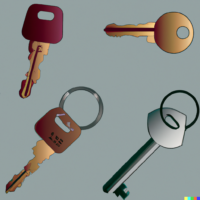With the rise of advanced chatbots such as OpenAI’s ChatGPT and Google’s Bard, professionals in every sector of the economy are asking themselves, “How can I implement this in my day-to-day work?” With the aid of these technologies, programmers can generate reams of code, lawyers can summarize large and complicated documents, and teachers can develop lesson plans. So how can property managers get in on the action? Well, we have some ideas, but chatbots are only a small piece of the larger pie: artificial intelligence (AI) is changing the property management and real estate landscape, and there’s a good chance you’re already using it. Here are 5 ways (including chatbots) to leverage AI and make your property management business more effective and more efficient.
1. Rent Optimization
Despite huge technological advances in recent years (and months), integrating AI into property management doesn’t necessarily mean automating all of its processes. You’re still going to want to exercise caution and carry out many things manually. Take rent optimization, for example. Determining the rent amount for each of your properties is a crucial step in balancing optimal revenue with minimal tenant turnover periods, and you don’t want to leave it up to algorithms to decide. Nonetheless, AI has still proven to be a useful research tool for the real estate industry.
Zillow’s Observed Rent Index (ZORI) utilizes proprietary statistical and machine learning models to measure changes in asking rents over time, so that property managers can get a sense of their markets based on not just properties currently listed for rent, but even those that are already being rented (plus it’s free to use).
Simply visit Zillow’s Housing Data website and scroll down to “Rentals,” select whether you want to view data by Metro & U.S., Zip Code, County, or City, and then click “Download.” You’ll then have a CSV file that you can consult to help in determining your rent amounts. As with all forms of AI, you’ll first want to get at least a basic understanding of how the technology is processing its data, so check out Zillow’s ZORI methodology before making any major decisions.

2. Virtual Leasing Assistants
Rental property vacancy is costly for many reasons, so it’s important to find new tenants as quickly as possible. Thanks to AI, the early steps of the leasing process are one area of property management that can be largely automated.
According to a 2018 study by Zillow, 71 percent of renters who inquire about a rental listing expect a response within 24 hours, and 20 percent want to hear back in an hour, or no more than a few hours. That’s a pretty small window of opportunity, and potential tenants are likely to move on to other options if you don’t reach out to them in time.
Virtual leasing assistants such as PERQ and ACE are able to field texts, emails and phone calls 24 hours a day, schedule tours, and collect contact information from potential renters. These tools are highly customizable, and can be attuned to match the voice and personality of your company. Virtual leasing assistants notify you and your staff when leads are identified and appointments are scheduled, so that a human can take over for the next steps of the process. By augmenting their onsite leasing teams with AI-based automation, property managers are able to fill vacancies sooner, and assign their employees to other important tasks.
3. Tenant Screening
This particular use of AI in property management piggybacks off of the virtual leasing assistants. Once you’ve identified a potential tenant who’s interested in the property and appears to meet all of your basic criteria, you’re still going to need to screen them.
Some products (such as TurboTenant, which boasts a 5-minute turnaround for credit/criminal background/eviction reports) offer AI-fueled tenant screening as one part of a larger package that includes tools for listing rental ads, creating lease agreements, and collecting rent. Others specialize solely on tenant screening itself. RealPage claims to possess the real estate industry’s “first—and only—AI-enabled scoring model” that can deliver “a strong predictor of future performance and renter behaviors.”
As with all of the products outlined in this article, you’ll still want to personally lay eyes on the outputs of such tools. You and/or your employees should carefully review the conclusions reached by these burgeoning technologies. It’s artificial intelligence after all, and AI can make mistakes, so humans are certainly still the primary decision-makers in any property management company.
4. Smart Homes
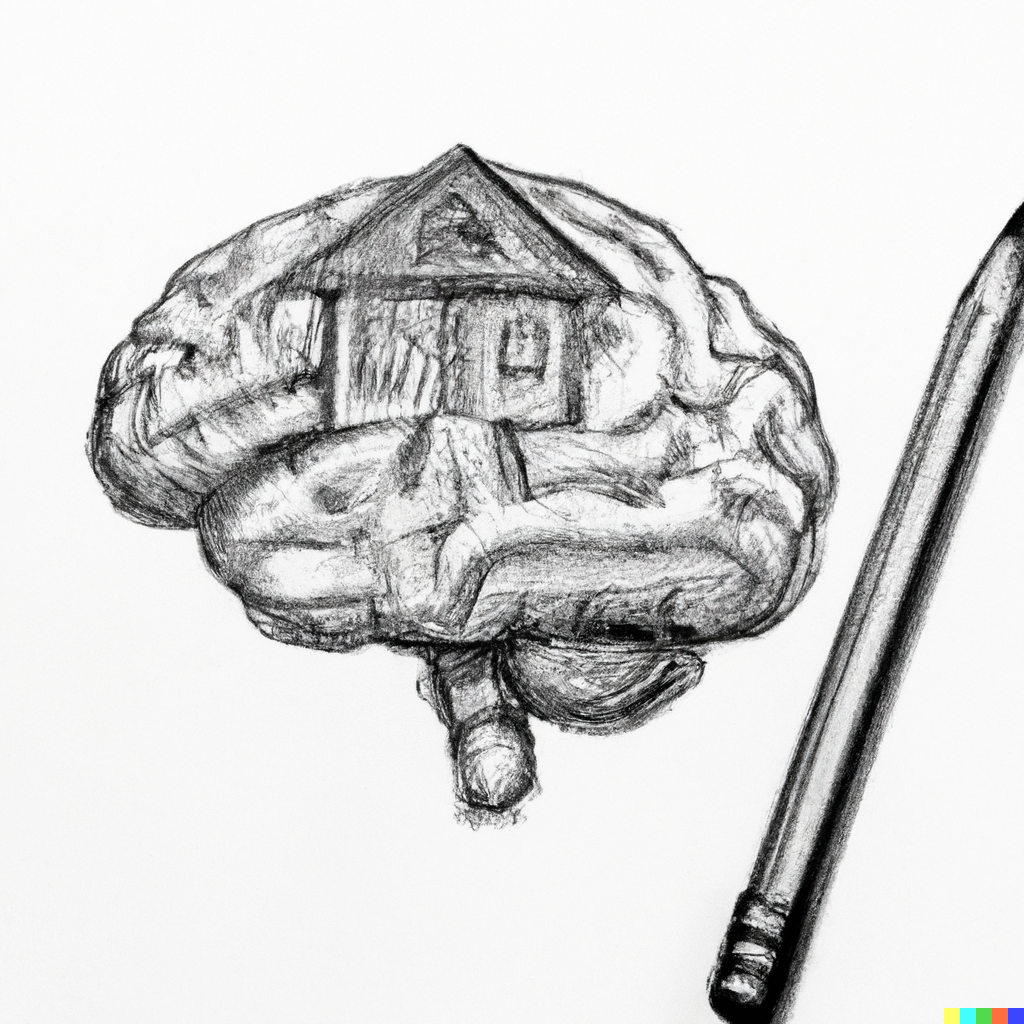
The term “smart home” has long been a part of the public consciousness at this point, but multifamily property managers can also outfit their apartments with the latest AI-infused technologies. Offering rental properties that are pre-equipped with smart home capabilities not only helps entice prospective tenants; it also potentially increases the likelihood that they will renew their leases.
Imagine wowing renters during their initial tour by being able to show them an app that can control lights, locks, and thermostats, manage security systems, and view real-time and recorded video from any location. Homebase offers just that: a suite of AI-based devices and features that can be integrated into each unit of a multifamily property.
Property managers who take advantage of such capabilities are able to reduce break-ins and package thefts, closely monitor and control energy usage, and secure perimeters and common areas. That’s a solid list of selling points that discerning renters are actively seeking in today’s market.
5. AI Chatbots
If you aren’t living under a rock, you’ve probably seen a lot of buzz about ChatGPT and other chatbots in your newsfeeds, and rightly so. These AI chatbots are based on large language models and use deep learning techniques to draw from huge datasets and answer (or attempt to answer) virtually any question a user puts to it. At the time of this writing, however, what we know about these technologies seems to change every day, so exercise caution when using them.
So how can landlords use AI chatbots? One of the safest and most effective ways to use these tools in the early stages of their development is to approach them as a simple brainstorming tool, a jumping-off point that can lead you to more meaningful and trustworthy sources of information. Let’s say you’re unhappy with the caliber of prospective tenants that have been contacting you about your properties. Below is a screenshot of an interaction with ChatGPT in which we asked it how we might go about tackling such a problem.
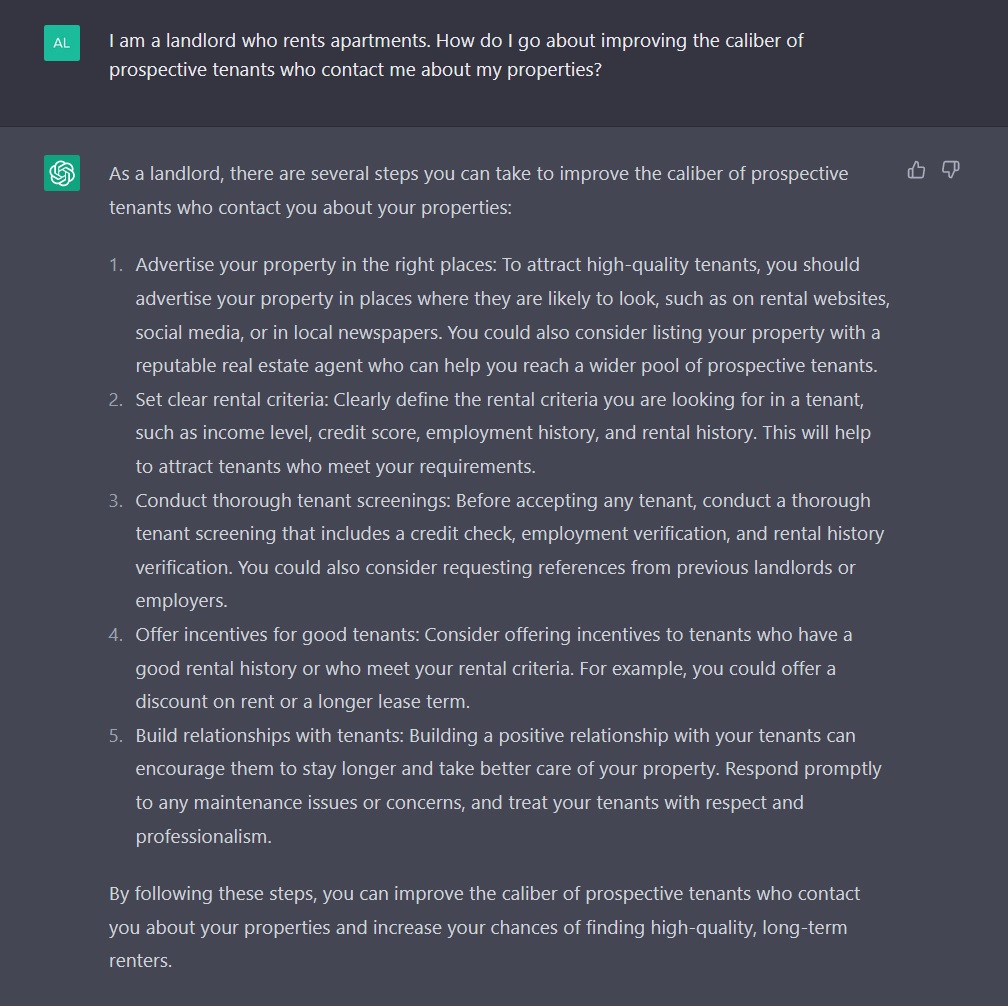
Sure, most of these suggestions may seem obvious or even downright unhelpful, but remember: we don’t know what we don’t know, and sometimes in our singlemindedness we overlook even the most obvious alternative solutions to our problems. Chatbots can help round out these blind spots the same way an extra pair of eyes can pinpoint typos that we ourselves have missed after multiple rounds of editing.
But what makes these new chatbots so revolutionary is their reflective and conversational nature. After ChatGPT gave us the answer shown above, we asked it: “What are some lesser-known ways to improve the caliber of prospective tenants?” Here was its answer:
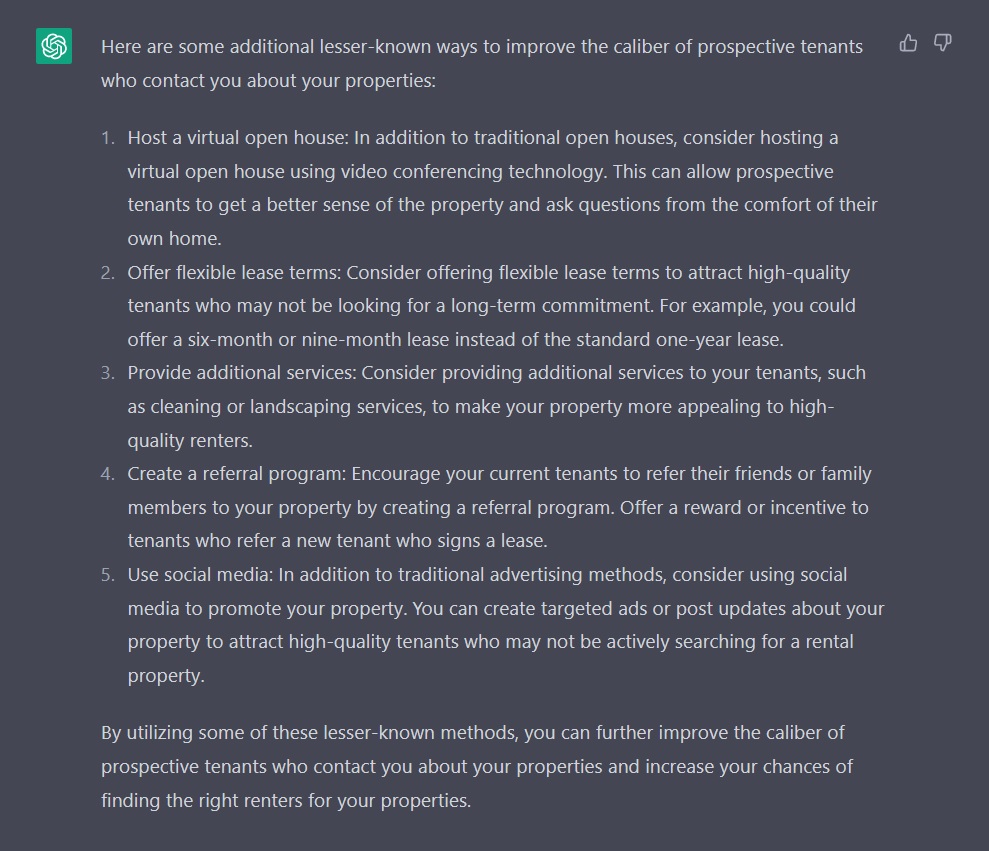
As you can see, ChatGPT is able to recall earlier segments of a conversation, enabling its users to delve deeper into subjects. You can also click “Regenerate response” to ask it the same question again, which often yields different results (when we regenerated the response to the “lesser-known ways” prompt above, ChatGPT suggested new ideas such as attending networking events and working with relocation companies).
ChatGPT is also adept at quickly generating copy for virtually any form of writing, including rental listings. Feed it enough details, and it will offer up surprisingly accurate and well-written results that are tailored to your rental. Say you have an apartment complex in downtown Overland Park that you need a new listing for. Here’s an example of how you might use ChatGPT to generate a first draft:
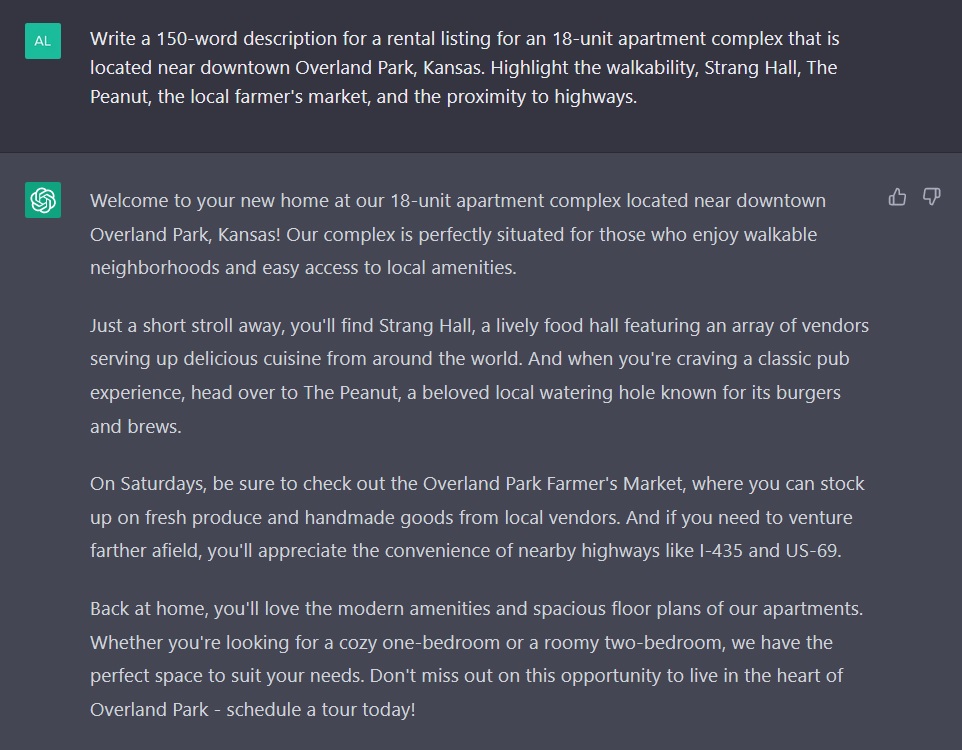
But then, in reading the results, you realize that you should have been more specific about the kind of complex it is, and the fact that you have a swimming pool you’d like to advertise. No need to start over. Just ask ChatGPT to address your concerns:
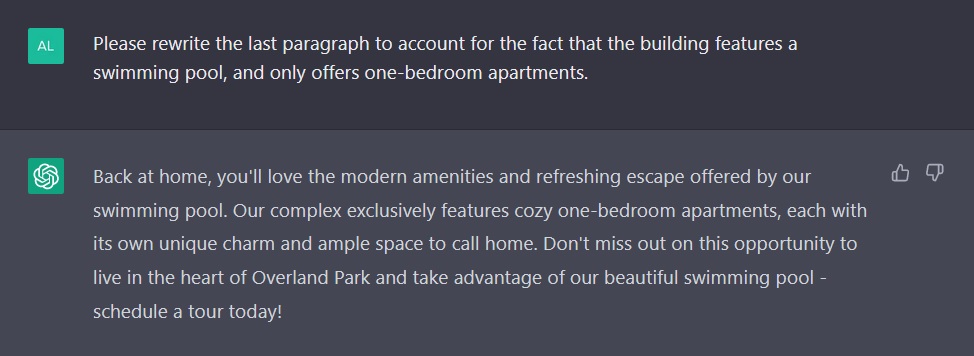
Yes, there’s still a lot you can do to liven the listing up, but you just skipped perhaps the most difficult task in any form of writing: putting pen to paper. As you can see, ChatGPT is a powerful AI tool that can be applied to many day-to-day property management tasks.
We recommend that you carry out your own such experiments with chatbots to learn about their strengths and weaknesses, and always remember to take their outputs with a grain of salt. Before making any significant business decisions based on what a chatbot has told you, double-check and verify the information.
It’s also worth mentioning that OpenAI, the maker of ChatGPT, has also produced DALL-E, a 12-billion parameter version of GPT-3 that can create AI-generated images based on simple text descriptions. The implications for advertising and web design are far-reaching and manifold.
Now, instead of spending hours combing through stock photo websites in search of the perfect picture of a set of keys (there are only so many ways to depict a landlord renting an apartment to a tenant), property managers can enter a query into DALL-E to generate unique images for their websites and promotional materials.
In our experience with DALL-E, we’ve found that (at least at this point) it’s still not able to consistently generate believably photorealistic images, especially when the query calls for the inclusion of a human figure. There are often tiny anatomical errors, or things that just don’t look right. For that reason, we recommend adding modifiers such as “oil pastel,” “colored pencil,” or “stylized.” For example, check out some of these example images that DALL-E generated:
Yes, that sign was supposed to say “For Rent.” Other than that, not bad, right? As with chatbots and other machine learning tools, AI image generators are improving every day as they continue to learn from their interactions with users, and we’re sure to see improvements in the coming months.
It’s also important to note that DALL-E generates its images based on massive datasets pulled from the internet, and so the ethics and legality of using such a technology (in regard to intellectual property) are still being hotly debated.
In addition to DALL-E, there are a number of other AI image generators out there, and many offer free trials. Give them a spin and see what kind of value they could add to your property management business.
AI Still Has Limitations
AI is rapidly revolutionizing every sector of the economy, and property management and real estate stand to gain much from advances in automation and machine learning. But you still need real humans doing real work if you want to remain relevant. ChatGPT and virtual leasing assistants are remarkable tools, but they’re limited in their capabilities. And even if you take advantage of more sophisticated AI-powered proptech such as Particle Space, there’s always room to bolster your business with our smarter property maintenance solutions. In this new technological landscape, Lula’s got you covered.
Anything found written in this article was written solely for informational purposes. We advise that you receive professional advice if you plan to move forward with any of the information found. You agree that neither Lula or the author are liable for any damages that arise from the use of the information found within this article


